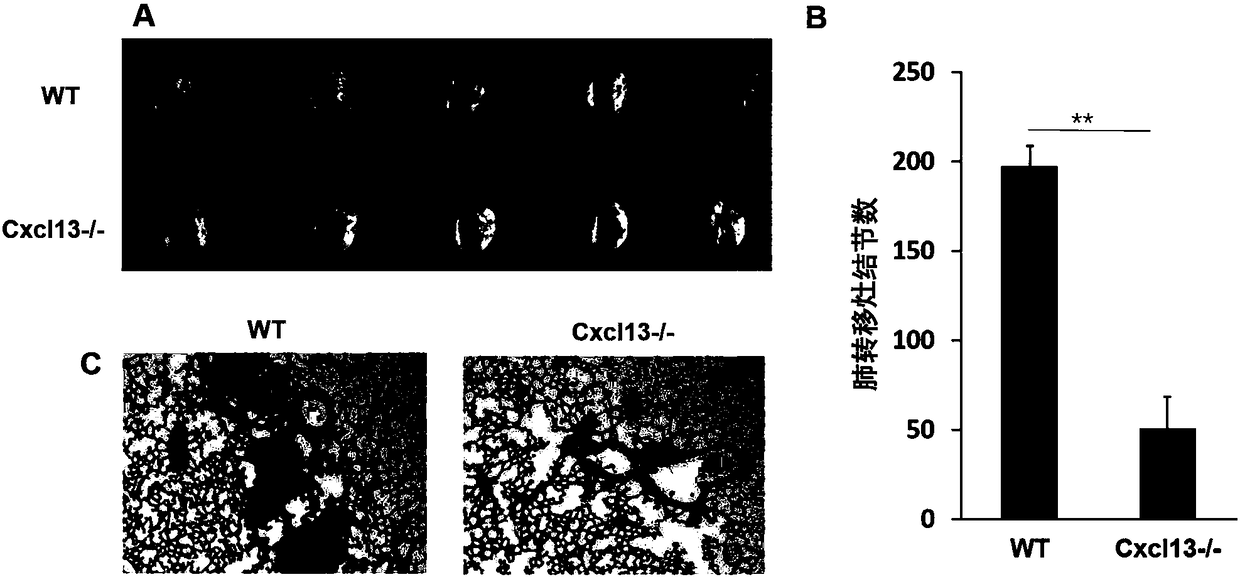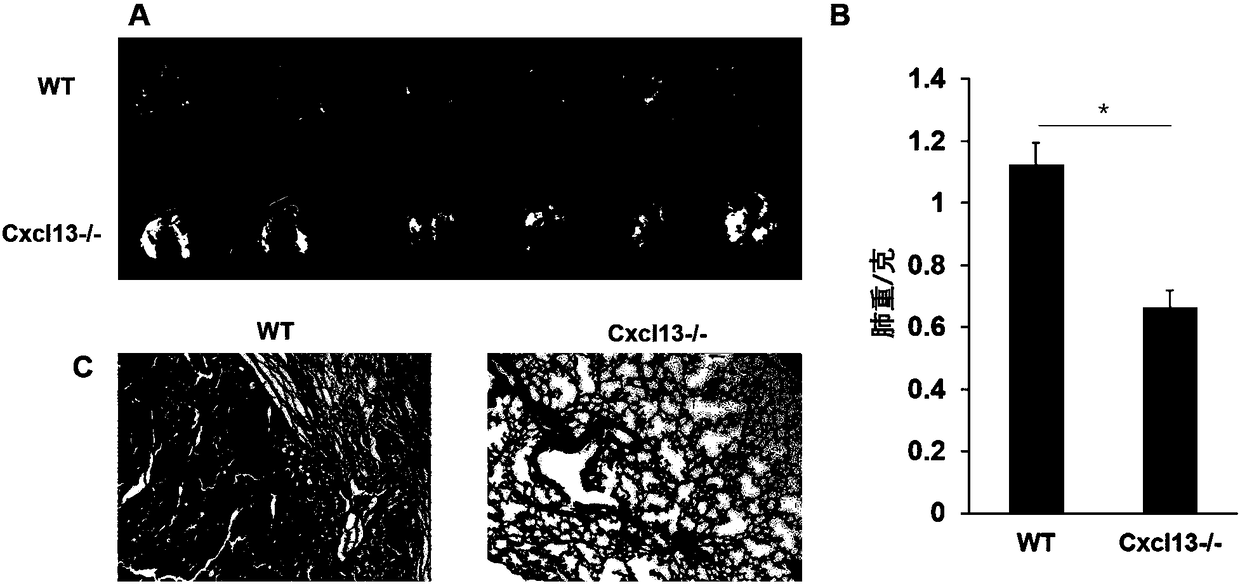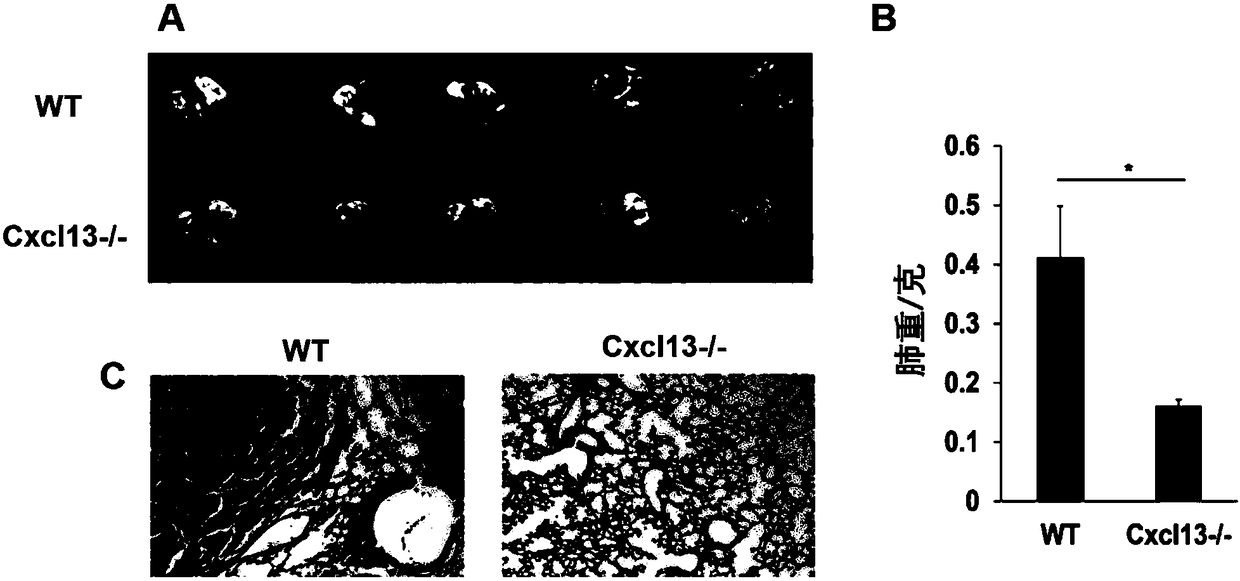Use of active substances for reducing activity or expression quantity of CXCL13 protein in preparing medicines for treating malignant tumor metastasis
A technology of active substances and protein activity, which is applied in antineoplastic drugs, gene therapy, drug combinations, etc.
- Summary
- Abstract
- Description
- Claims
- Application Information
AI Technical Summary
Problems solved by technology
Method used
Image
Examples
Embodiment 1
[0112] Embodiment 1. Experimental lung metastasis experiment of melanoma
[0113] 1. Tumor cell culture and establishment of metastatic tumor model:
[0114] (1) Melanoma B16 cells are cultured in DMEM medium (containing 10% fetal bovine serum). When the cells grow to about 50-70% in the plate, digest with trypsin at 37°C for about 2 minutes, neutralize the medium and pipette the remaining paste Parietal cells were transferred to a 15 ml conical centrifuge tube, centrifuged at 1500 rpm for 3 minutes, and the supernatant was discarded.
[0115] (2) The cells were resuspended and washed in serum-free DMEM medium, and centrifuged at 1500 rpm for 3 minutes. repeat.
[0116] (3) Count cells, resuspend concentration 1*10 6 / mL, each mouse was given 2*10 5 individual tumor cells, 200 μL.
[0117] (4) The mice were killed by neck dislocation 14 days or 21 days after inoculation of tumor cells, the chest cavity was opened to take out the lungs, and the blood clots were washed away...
Embodiment 2
[0157] Embodiment 2. Experimental Lung Metastasis Experiment of Lewis Lung Cancer
[0158] 1. Tumor cell culture and establishment of metastatic tumor model:
[0159] (1) Lewis lung cancer LL2 cells are cultured in DMEM medium (containing 10% fetal bovine serum). When the cells grow to about 50-70% in the plate, digest with trypsin at 37°C for about 1 minute, neutralize the medium, and pipette the remaining paste Parietal cells were transferred to a 15 ml conical centrifuge tube, centrifuged at 1500 rpm for 3 minutes, and the supernatant was discarded.
[0160] (2) The cells were resuspended and washed in serum-free DMEM medium, and centrifuged at 1500 rpm for 3 minutes. repeat.
[0161] (3) Count cells, resuspend concentration 1*10 6 / mL, each mouse was given 2*10 5 individual tumor cells, 200 μL.
[0162] 21 days after the inoculation of tumor cells, the mice were killed by neck dislocation, the chest was opened to take out the lungs, and the blood clots were washed awa...
Embodiment 3
[0166] Example 3. Lewis lung cancer spontaneous lung metastasis experiment
[0167] 1. Tumor cell culture and spontaneous metastasis model establishment:
[0168] (1) Lewis lung cancer LL2 cells are cultured in DMEM medium (containing 10% fetal bovine serum). When the cells grow to about 50-70% in the plate, digest with trypsin at 37°C for about 1 minute, neutralize the medium, and pipette the remaining paste Parietal cells were transferred to a 15 ml conical centrifuge tube, centrifuged at 1500 rpm for 3 minutes, and the supernatant was discarded.
[0169] (2) The cells were resuspended and washed in serum-free DMEM medium, and centrifuged at 1500 rpm for 3 minutes. repeat.
[0170] (3) Count cells, resuspend concentration 1*10 7 / mL, each mouse subcutaneously administered 1*10 6 individual tumor cells, 100 μL.
[0171] (4) 14 days after tumor cell inoculation, the subcutaneous tumor was surgically removed.
[0172] (5) Eleven days after surgical removal of the subcutan...
PUM
 Login to View More
Login to View More Abstract
Description
Claims
Application Information
 Login to View More
Login to View More - R&D
- Intellectual Property
- Life Sciences
- Materials
- Tech Scout
- Unparalleled Data Quality
- Higher Quality Content
- 60% Fewer Hallucinations
Browse by: Latest US Patents, China's latest patents, Technical Efficacy Thesaurus, Application Domain, Technology Topic, Popular Technical Reports.
© 2025 PatSnap. All rights reserved.Legal|Privacy policy|Modern Slavery Act Transparency Statement|Sitemap|About US| Contact US: help@patsnap.com



